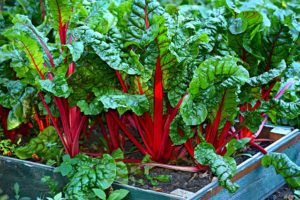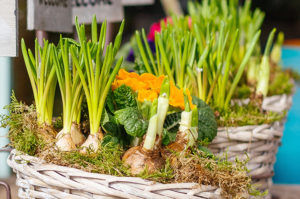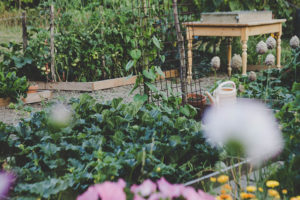Spring is just around the corner for many of us and it’s already here in some parts of the U.S. so now is the time to prepare to garden in limited space.
In most of the country, February and March is the time to begin planning and organizing your prepper garden so when the weather breaks, you can hit the ground running!
If you are like me, I can’t be at my bug-out location (BOL) all the time to take care of a garden. Gardens need attention almost daily if you want a fruitful harvest. Therefore, planting a garden in my small backyard just makes sense.
There are some planting methods and vegetables that are better suited to small spaces. I’m going to go over a few here to help you get started gardening when space is limited.
What Type of Garden is Best for Small Spaces?
There are advantages and disadvantages to each of the following growing methods, but I urge you to consider each depending on the space you have available. The methods I cover below can be built out of existing scrap lumber or by gathering common things such as pallets.
For container gardening, you don’t need an expensive pot to grow, a simple five-gallon bucket will work just fine, just remember to drill holes for ample drainage.
Raised Bed Gardening

I love raised bed gardening, for two reasons, it is easier on my back and you don’t have to till the ground before planting. This is a great way to make use of gardening in smaller yards and spaces, especially if you don’t want to invest in a tiller.
Working the soil and adding nutrients will take a lot less effort because you will be starting with the right soil mix from the start.
In my area of the woods, the soil isn’t all that great so I would have to really doctor up the ground before I could plant, raised beds to solve that issue.
Further, you can choose how high you build your beds to allow for quicker and deeper roots and less back strain.
Another great benefit of raised bed gardening is that fact that it can cut down on the amount of weeding you will have to do. When you start with fresh soil mix, it is weed seed free and the raised bed tends to keep blowing seeds from getting rooted down a bit.
Raised bed gardening can also help the soil from becoming compacted due to human traffic and heavy rain. This will promote healthy roots and therefore, healthy plants! You will also lose a lot fewer nutrients to drainage like you would with a typical garden.
Container Gardening
Container gardening is perfect for those in apartments or condos that don’t really have room for a raised bed garden. Even those in the city find ways to plant in small spaces, just look at some of the rooftop gardens in the cities.
One of the biggest benefits to container gardening is it’s portable!

Not only does gardening in pots allow you to have a portable garden but that portability means you can bring plants in when a freeze is imminent. You can move them around and allow them to capture the best sunlight or shade.
You have the ability to mix the soil to your specifications as you do with raised bed gardening making your plants much healthier. Folks are doing amazing things with small spaces so use your imagination and take advantage of every space you have.
Combine your container gardening with your landscape for an incredible addition of color. And like raised bed gardening, weeding is much easier in containers.
Make sure you size your containers correctly with the size of the plant, and you can grow healthy plants that can provide vegetables well into the non-growing season.
Read the directions that come with the plant to get an idea of how much root room you will need.
Here are some common containers you can use for your plants:
- Buckets
- Bushel baskets
- Flower pots
- Large food cans
- Nursery flats
- Pails
- Plastic bags
- Strawberry pots
- Wire baskets
- Wooden boxes
- Window planters
- Washtubs
Just remember, if you are using something with no drainage such as a five-gallon bucket, it should have holes drilled in the base or in the bottom to permit drainage of excess water. Vegetable plants will die if left sitting in wet soil.
Stack Container Gardening
Stacking is a technique that you can use to maximize your vertical space. With a little bit of ingenuity and some strong shelving, you can create a healthy garden by growing up.
I have even seen some creative folks create tiered gardening with free pallets you can find just about anywhere.
Portable Natural Fabric Bags
There is a fairly new product available today, at least it is new to me. I think it is a great idea, so I decided to include it here.
Fabric planting bags provide excellent root aeration and a stronger root system. Unlike many of the root bags that you purchase plants in, the fabric bags allow for air pruning.
When the roots contact the air, the roots are air pruned then the plant begins to create new feeder roots.
This creates a larger root mass that can consume more water and nutrients allowing your plant to grow bigger and provide more veggies.
Another benefit to the fabric bags is that it’s more difficult to over water. The porous fabric allows excellent drainage to help prevent overwatering. Overwatering is one of the main causes of mold and other pathogens building up in the soil.
The fabric bags allow more oxygen to penetrate all around the root system. This air circulation is exceptionally beneficial in hot and humid areas.
Finally, these bags are flexible and easily stored through the winter or you could move them indoors if you have space. This will extend your growing season if you are in a colder climate.
The Benefits of Companion Planting
Companion planting is a process of planting compatible plants next to each other having them share the benefits of each plant. But this is essentially what Mother Nature already does so it makes sense for us to use this method as well.
This method will attract beneficial insects to keeping pests away and provide physical support to plants that grow tall and produce heavy fruits.
When we talk about gardening in small spaces and getting the most of your space, companion planting is a great idea. Where space is a concern, companion planting allows you to use every bit of garden space you have for optimal efficiency.
Here are the basic premises of companion planning:

- Plant vine plants such as squash and cucumbers under taller plants such as corn. The corn will allow for a trellis for the cucumbers and squash to grow while the vine plants large leaves keep the weeds down.
- Lettuce will produce much longer if shaded by larger and taller plants while keeping the weeds from getting sunlight.
- Vegetables that are harvested earlier, such as lettuce, spinach, radishes, and peas, can be planted with slower-growing crops such as broccoli or peppers. This will keep them from taking over space until the spring-harvested vegetables are long gone.
- Clustering plants with complementary attributes together such as moisture and shade plants next to taller and more drought-resistant plants.
- Some plants create odors that confuse and repel pests. Marigolds tend to be a great plant for pest prevention so plant them within other plants such as cabbage.

Radish the Plant Pests Decoy - Other annual herbs such as coriander, anise, and mustard as well as parsley and garlic act as a protective deterrent when interplanted between rows of vegetables. This will also help with nutrients imbalance in the soil.
- Plant vegetable such as beans, peas, and sweet peas in areas where more nutrient hungry plants were grown. Legumes leave more nutrients in the soil than they take making them a great fall fertilizer.
- Basil, dill, sage, and thyme all attract beneficial pollinating insects such as spiders to help control pests.
- Plant decoy plants such as radishes. Radishes tend to draw destructive beetles away from other plants and they are easy and fast to grow.
Plants That Grow Well Together
| Vegetable | Companion Plant | Don’t Plant Together |
| Asparagus | Tomatoes | None |
| Beans (Bush or Pole) | Celery, corn, cucumbers, radish, strawberries, and summer savory | Garlic and onion |
| Beets | Bush beans (not pole beans), cabbage, broccoli, kale, lettuce, onions, garlic | Pole beans |
| Cabbage Family (cabbage, broccoli, kale, Brussels sprouts) | Beets, celery, dill, Swiss chard, lettuce, spinach, onions, potatoes | Pole beans |
| Carrots | Beans, tomatoes | None |
| Celery | Beans, tomatoes, cabbages | None |
| Corn | Cucumber, melons, squash, peas, beans, pumpkin | Tomatoes |
| Cucumber | Beans, corn, peas, cabbage | None |
| Eggplant | Beans, pepper | None |
| Melons | Corn, pumpkin, radish, squash | None |
| Onions | Beets, carrots, Swiss chard, lettuce, peppers | All beans and peas |
| Peas | Beans, carrots, corn, cucumbers, radish, turnip | Garlic, onions |
| Potatoes | Beans, corn, peas | Tomatoes |
| Squash | Corn, melons, pumpkins | None |
| Tomatoes | Carrots, celery, cucumbers, onions, peppers | Corn, potatoes, kohlrabi |
Finally
Maximize your plant efficiency by rotating your plants each year. Disease and pests tend to stick around where you planted the year before. By rotating your crop, you can cut down on pests and disease.
Don’t let small spaces keep you from planning a vegetable garden. There are many options out there for those with limited space.
Keep planting and enjoy the process and the rewards!

